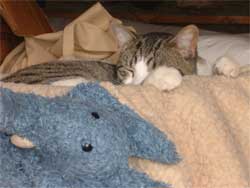Strange disease: A patient with lymphadenitis caused by cat bugs

Dogs and cats live together
The 38-month-old TTH patient in Hanoi was found to have lymphadenitis caused by cat bugs, a strange and rare disease. After more than 1 month of treatment has returned to normal.
On September 24, ABCD pediatric clinic, in Giang Van Minh street, Hanoi, received a patient with different symptoms at the same time, especially with the phenomenon of lymph nodes , sores on both sides of the neck. .
According to the family's patients, the lymph nodes appeared 1 month but they had no signs of fever, antibiotic treatment at Bach Mai hospital but did not help. Next, the family moved her to the Central Children's Hospital. Here, the patients are treated with Battarium with some other drugs.
Also at ABCD clinic, doctors said that H. had signs of acute pharyngitis, 2 lymph nodes on both sides of the neck broke pus, and appeared many small nodes growing on both sides of the neck. The patient was diagnosed with pseudomembranous lymphadenitis and was treated with antibiotics by Cefuroxim Zinat with some other supportive drugs.
"The culprit is a cat bug"
In parallel with bringing children to many places for testing, doctors of the Central Pediatric Hospital have poked pus to clarify the cause of the disease. However, there are many contradictions during testing and it is difficult to explain the illness. In pediatric lymph nodes containing lymphocytes, doctors make two hypotheses: cataracts or tuberculosis.
However, the test results of the Institute of Tuberculosis and Central Lung Disease were negative for tuberculosis. Finally, Dr. Tran Thi Thu Ha, Deputy Head of the Rehabilitation Department, Central Children's Hospital, sent medical records and test results to the US through medical experts.
According to the results of American experts' examination, H. patient suffers from cat-like lymphadenitis, and offers treatment regimens with 3 major Bactrim antibiotics; Cefotaxime and Azithromycin.
After a period of treatment according to the regimen of American experts, H patient has completely cured. According to the mother of the pediatric patient H., the family raised cats and grandchildren H. often played with it.
Le Ha
- The cold warning specialist of 'bug kissing' infects 300,000 people
- The strange disease caused the patient's bones to
- The lethal strange disease for the first time recorded in Vietnam
- Things to know about kissing bugs
- The secret to destroy bed bugs without chemicals
- Blood-sucking stink bugs are capable of attacking the globe
- Blood sucking bugs contain parasites and drug resistance
- The man who was bitten by the bug was unconscious
- Blood-sucking stink bugs are raging in America
- Blood sucking bugs are quietly spreading around the world
- The Ministry of Health officially spoke about kissing bugs
- Strange sleeping sickness once spread the nightmare in the world
 Green tea cleans teeth better than mouthwash?
Green tea cleans teeth better than mouthwash? Death kiss: This is why you should not let anyone kiss your baby's lips
Death kiss: This is why you should not let anyone kiss your baby's lips What is salmonellosis?
What is salmonellosis? Caution should be exercised when using aloe vera through eating and drinking
Caution should be exercised when using aloe vera through eating and drinking